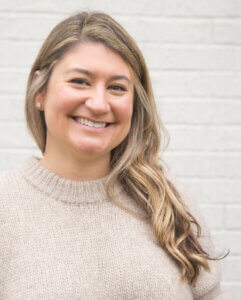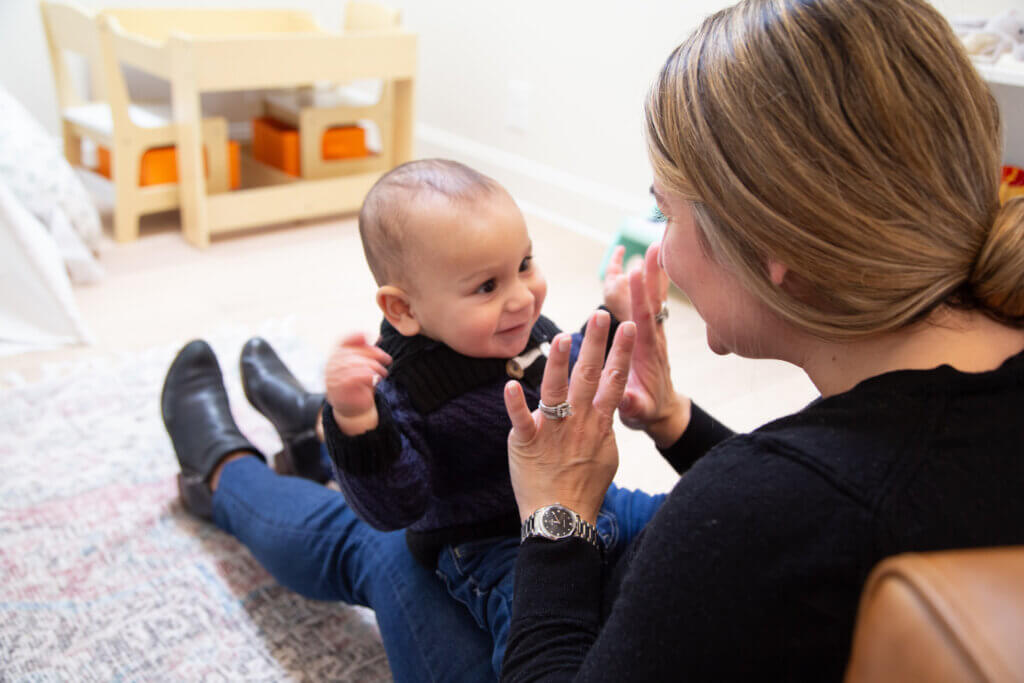Did you know that teaching your child to communicate starts long before they can use full sentences? These simple strategies can help you notice and nurture your child’s language skills. You can begin supporting communication from their first days of life. These tips are especially helpful for children in communicating in the 0-24-month range and 24-36-month range. During this stage, kiddos are starting to communicate with gestures, sounds, and first words and phrases. This is an exciting time in language development, and as parents, we can be in tune with our child’s unique language skills.
Pay Attention to Gestures
Gestures can be the bridge to sounds and words. Watch your child’s gestures, like facial expressions, pointing (even with a whole hand!), looking, crawling, or walking toward something. If you’re unsure what counts as a gesture, try observing yourself in a mirror or using your phone’s camera to notice your own expressions and body movements while communicating.
Paying attention to gestures helps you understand how your child communicates and gives you a foundation to expand their language. When we pay attention to the gestures our kiddos are using, we can individualize the learning opportunities we target within their specific knowledge base (1).
When our kiddos learn to point or look in the direction of a new sound or thing in their environment, we respond by telling them what that sound or thing is and showing them a new word or phrase!
Keep a Quick Notes List
Tracking your child’s communication in this way gives you a clear picture of their progress and makes it easier to celebrate growth.
Here’s a simple way to track your child’s communication:
- Pick two daily routines you enjoy with your child (bathtime, snack, reading, playing with blocks, or snuggles).
- Set a five-minute timer and just watch and listen.
- Write down all the gestures, sounds, or words your child uses.
For example, my baby loves bathtime and bubbles! During the bath, I keep my phone nearby and type any gestures or sounds I notice. This helps me be in tune with his unique language and my responses to his communication during one of our favorite times of the day. Pro tip! When you can come back to your list and celebrate their communication! Think of how you could practice using the gestures they have during other times of the day.
I also try to pay attention to what I am doing to respond to each gesture, sound, or word. First, focus on their sounds, words, and gestures. Then, when you’re ready, write down your response to their communication. The main point is that we are creating these back-and-forth “conversational turns” with our kiddos early on. Pro Tip! Make sure your responses are positive and expand on what is interesting to your child. This can help the interaction continue next time!
You can also track your child’s gestures and communication habits with a simple chart:
| Date | Routine or time of day | Sounds, words, or gestures used | My response |
| Ex: Tuesday, October 12th | Bathtime | Sh sh
Pointing to bubbles Putting the washcloth on his arm |
I imitated the “sh sh” sound, and we began a back-and-forth
I labeled my child’s “arm” when they put their washcloth on their arm |
Press Pause and Celebrate
Pressing pause to look at the gestures, words, and sounds your child is using to communicate is an exciting moment! It doesn’t matter what stage of communication milestones your child is working towards right now; in this moment, you’re celebrating them! Tell them you’re proud of their pointing or silly facial expression they made with you.
Celebrating their unique language skills teaches your kiddo that you value their communication attempts and you’re interested and invested in their unique communication journey. This celebratory moment you have together will help to build your relationship while teaching your child the value of communicating with you. At our house (and in my clinic sessions when I work with kiddos who love music), we celebrate by singing and dancing. I’ll make up a song or do a quick dance and tell my son, “You should be so proud of that beautiful point!”
Imitate Them
It may feel a little silly, but it’s important to imitate your child’s sounds, words, or gestures. This back-and-forth, called conversational turns, is very important for language development. Children who have more conversational turns with caregivers often develop stronger language skills and better brain responses for understanding and using language (2).
By imitating your child intentionally throughout the day, you also model communication for them—they learn that language is meaningful and entertaining! Teaching toddlers is so much fun; you get to be as silly as you want, and you can both laugh and learn together.
Build on Their Communication
Now that you’ve noticed gestures, sounds, and words, help your child expand their communication. For example, if your child makes a funny face at bathtime, try making the same face during mealtime. This teaches them that gestures and sounds can be used in many contexts, expanding their language skills.
For example, my kiddo loves watching construction machinery, and luckily, every day we can watch construction close to where we live. I take a few seconds, and when he points to the excavator, I immediately say “excavator” and “up and down” when the excavator begins to move its arm. This level of responding is perfect for my son’s language skills, as he is right now communicating at a one-word level. Build on your child’s language based on their language level, interest, and educational goals.
Celebrate every new sound, gesture, or back-and-forth interaction. Remember, every child develops at their own pace, and your attention and encouragement are key to their growth.
Being aware of your child’s communication helps you advocate for them and “interpret” their needs. If you ever have concerns about their communication, bring your notes to your pediatrician or contact your local speech and language clinic for a free screening.
For additional information, advice, and activities, grab a copy of my new book, Path for Words: Five-Minute Language Learning Activities for Children Ages One to Three Years.
 ABOUT THE AUTHOR
ABOUT THE AUTHOR
Marie Martinez, M.S., M.Ed., CCC-SLP, BCBA, LBA, is a dually certified professional in behavior analysis and pediatric speech-language pathology, with extensive clinical experience. As one of the few experts in both fields, Marie has contributed to research on parent coaching, asynchronous family supports, and family outreach. Marie serves as the professional development manager for the American Speech-Language and Hearing Telepractice Special Interest Group, advancing the field of telepractice. Marie is the founder of the Path for Words program, which supports caregivers in creating speech and language opportunities for their children’s development. A dedicated professional and a mother, she is committed to fostering lasting positive change in the lives of families. She is also the author of Path for Words
- Goldin-Meadow S. How gesture promotes learning throughout childhood. Child Dev Perspect. 2009 Aug 1;3(2):106-111. doi: 10.1111/j.1750-8606.2009.00088.x. PMID: 20228883; PMCID: PMC2835356.
- Romeo, R.R., Leonard, J.A., Robinson, S.T., West, M.R., Mackey, A.P., Rowe, M.L., & Gabrieli, J.D.E. (2018). Beyond the 30-Million-Word Gap: Children’s Conversational Exposure Is Associated With Language-Related Brain Function. Psychological Science, 29(5), 700–710.
RELATED ARTICLES
- Tips to Get Tots Talking + Signs Speech is Imminent
- Learning And Child Development: The Early Years
- Play is Learning
Cover photo provided by the author.

